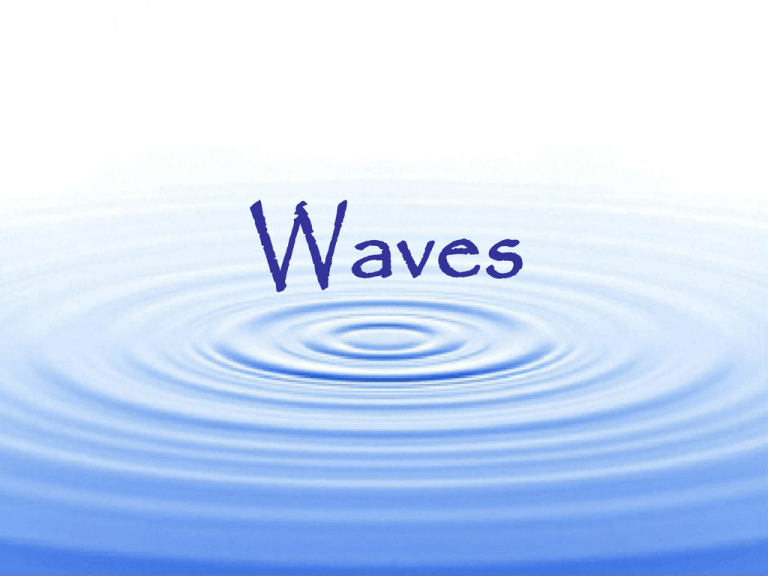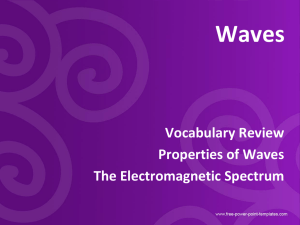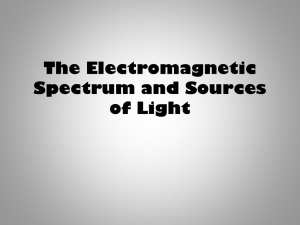Waves Pretest
advertisement

Waves Energy is sometimes transferred from place to place by traveling in waves. Sound and light travel in waves. Some substances transport energy through them in waves – like water waves. A wave is an energy disturbance that moves in a consistent manner. Some waves can travel through a vacuum (no matter), while others travel through matter (called a medium). Waves that pass through a medium do so without causing permanent movement of the medium. There are different types of waves with different types of movement. Ocean waves travel in transverse waves. A transverse wave causes particles to move up and down while the wave moves forward (perpendicular to the wave motion). Light waves also travel in transverse waves, however light waves are electromagnetic waves. Electromagnetic waves are able to travel either through a vacuum or within a medium. The Electromagnetic Spectrum Longitudinal waves (also called compression waves) move particles back and forth parallel to the wave motion. Sound and earthquake waves are longitudinal waves. Waves have properties and scientists use these properties to describe specific waves. Transverse waves have crests and troughs, a crest being the highest point of displacement, and the trough the lowest point of displacement. A node is the point where it crosses the median line. The wavelength of a transverse wave is defined as the distance from one crest (or top) of a wave to the next crest on the same side. The wavelength of a longitudinal wave is measured from the center of one compression to the center of the next. The frequency of a wave is the number of wavelengths that pass a point in a second. (You could count the frequency of ocean waves by standing in one place on a dock and counting how many wave crests pass in a given time period.) Frequency is usually measured in Hertz or cycles per second. The wavelength and frequency of the same wave are related. As frequency increases wavelength decreases and as frequency decreases wavelength increases. (Or you can say it the other way . . . As wavelength increases, frequency decreases, etc.). The amplitude of a wave is measure of the amount of displacement it causes. In other words, the amplitude is the distance from the center of the wave to it’s highest point. Waves also interact with each other in various ways. Wave interference can occur between waves. Interference can increase wave amplitude if the crests and troughs of the waves coincide. If the crest and trough of two waves coincide, they can cancel each other or reduce the amplitude. Waves can also be reflected when they hit a surface. SOUND Sound travels in longitudinal waves. Sound waves are made when an object vibrates and causes surrounding air molecules to take on a compression wave motion. This motion is picked up by our eardrums and translated in our brains into sounds. Sound waves can only travel in a medium (where there is matter). They can not travel in a vacuum. Changes in wavelength of sound waves cause volume changes, while changes in frequency result in pitch changes. Sound waves travel at a speed of 330 m/s in air at zero degrees Celsius. Sound travels at different speeds in different media (water, wood, etc.) and at different temperatures. LIGHT Light waves are transverse. Changes in wavelength (and thus frequency) cause light to appear in different colors. When white light waves (like sunlight) pass through a prism the various wavelengths are separated out into a spectrum. There are light wavelengths that are visible and some that are invisible to the human eye. The visible spectrum includes red, orange, yellow, green, blue, indigo, and violet light. When red, orange, yellow, green, blue, and violet are combined, they produce white light. This entire visible spectrum can be seen in rainbows, puddles with oil, as light passes through water, etc. Light waves travel in straight lines. When light waves pass through a small opening they cross each other turning the image upside down. Light waves can be reflected. Light waves can also be refracted (bent). When our eye looks at the pencil in water, it looks broken because the light waves have been bent by the differing substances (air is less dense than water). Speed of Light The velocity of light waves is consistent at 299,792,458 m /s. Waves are constantly surrounding us with light, sound, and lots of other types of energy! Words to Remember amplitude trough crest wavelength frequency pitch electromagnetic spectrum transverse wave longitudinal wave 1. crest 2. trough 3. wavelength 4. node 5. amplitude Which numbered term above goes with A on the picture? (Answer with a number 1-5.) 1. crest 2. trough 3. wavelength 4. node 5. amplitude Which numbered term above goes with B on the picture? (Answer with a number 1-5.) 1. crest 2. trough 3. wavelength 4. node 5. amplitude Which numbered term above goes with C on the picture? (Answer with a number 1-5.) 1. crest 2. trough 3. wavelength 4. node 5. amplitude Which numbered term above goes with D on the picture? (Answer with a number 1-5.) 1. crest 2. trough 3. wavelength 4. node 5. amplitude Which numbered term above goes with E on the picture? (Answer with a number 1-5.) What is a wave? A: traveling energy that causes a temporary disturbance B: permanent movement of a medium C: energy that can only travel in a vacuum D: energy that can only travel through matter Which of the following is NOT true? Sound waves A: are compression waves. B: are longitudinal waves. C: must travel through a medium. D: are transverse waves. Transverse waves A: have a series of compressions and rarefactions. B: move particles perpendicular to direction of the wave. C: have no amplitude. D: must always travel through a medium. Electromagnetic waves are unique because A: they are the only type of transverse waves. B: they are the only type of compression waves. C: they can travel in a vacuum. D: they require a medium in which to travel. Which is true of light waves? A: they are transverse waves. B: they are electromagnetic waves. C: they can not travel in a vacuum. D: A & C only In longitudinal waves A: particles move back in forth in motion parallel to the wave motion. B: particles move up and down in motion perpendicular to the wave motion. C: the particles in the medium are permanently displaced when a wave passes through. D: there is no temporary displacement of particles as the wave moves through. The frequency of a wave is A: measure of the height of a wave. B: the same as the wavelength. C: the same as wave velocity. D: the number of wavelengths that pass a point in a given period of time. As the wavelength of a wave increases A: the frequency remains the same. B: the velocity increases. C: the frequency decreases. D: the frequency increases. Some wavelengths of light are not visible to the human eye. A: True B: False Red light has a shorter wavelength than violet light. A: True B: False Yellow light, X-rays, microwaves, and radio waves are all parts of the electromagnetic spectrum. A: True B: False Red, orange, yellow, green, blue, and violet light wavelengths combine to form A: black light B: the entire electromagnetic spectrum C: white light D: infrared light Sound waves are affected by temperature and density of the medium they travel in. A: True B: False Different colors of light have different A: crests B: amplitudes C: wavelengths D: speeds Changing the frequency of a sound wave changes the A: volume B: amplitude C: pitch D: tone






